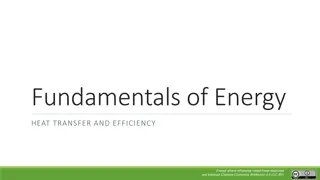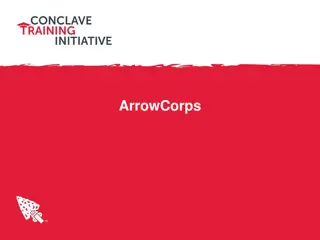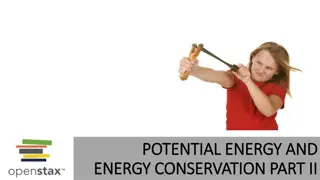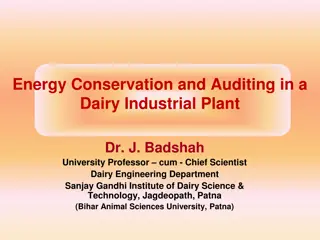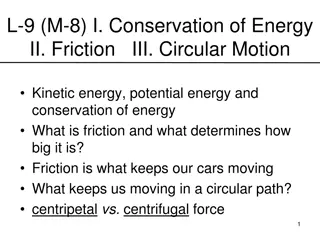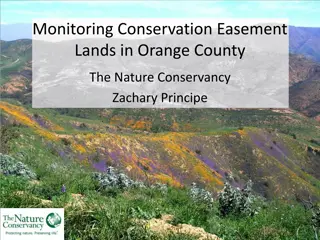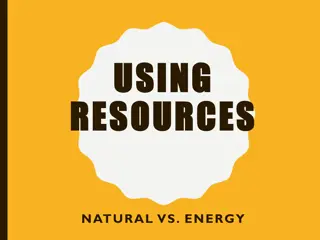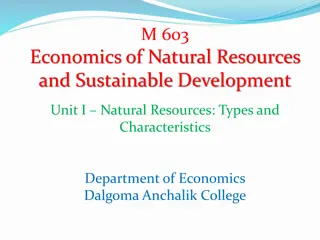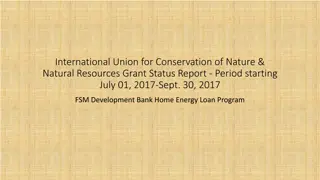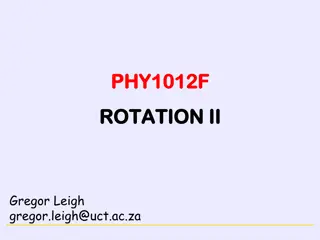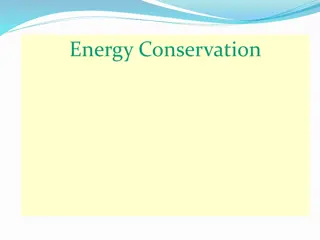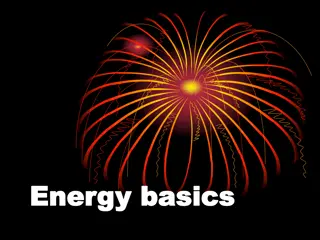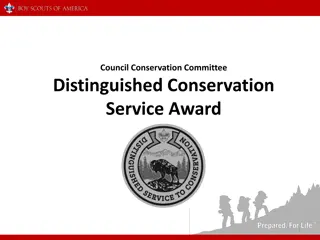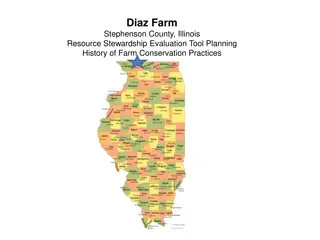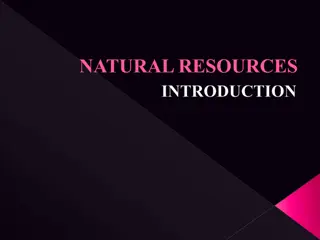Understanding Natural Resources and Energy Conservation
Explore the impact of natural resource usage on the Earth through engaging lessons, hands-on activities, and informative videos. Learn about renewable and non-renewable resources, the importance of fossil fuels, and the challenges associated with energy production. Discover interactive resources and educational tools to deepen your understanding of conservation efforts and sustainable practices.
Download Presentation

Please find below an Image/Link to download the presentation.
The content on the website is provided AS IS for your information and personal use only. It may not be sold, licensed, or shared on other websites without obtaining consent from the author. Download presentation by click this link. If you encounter any issues during the download, it is possible that the publisher has removed the file from their server.
E N D
Presentation Transcript
Energy and Conservation/ Natural Resources Chpt. 17
USATESTPrep 5/4 New assignments on USATESTPrep Interactive Note If you do any of the pages you can take a picture on your phone and send to my email. May write on own paper and make sure you title it
Interactive Notebook 4/20 Natural Resources.pdf
Overall Driving Question How does the use of natural resources effect the Earth?
Lesson 1Introduction of Anchoring Phenomenon & Concept:_ Nonrenwable/RenewableResources Chocolate Chip Cookie Mining Full lesson plan available at the following link: https://www.calacademy.org/educators/lesson-plans/fossil-fuels-chocolate- chip-mining
Renew-A-Bean Lab Activity https://www.epcc.edu/InstructionalPrograms/geologicalsciences/Geology%201 102%20Lab/1102%20Lab%20Renewable%20and%20Non- renewable%20Resources.pdf
Renewable Resources Game Show (9min) https://www.youtube.com/watch?v=6_adfcO8clo Natural Resources Slide Show and Assessment Questions http://studyjams.scholastic.com/studyjams/jams/science/energy-light- sound/natural-resources.htm
Lesson 2 Investigative Phenomenon: Most energy in the United States is produced by coal, petroleum, and natural gas. Petroleum is also made into a lot of everyday items, from toothpaste to laptops. Driving Question(s): What is the difference between a renewable and non renewable resource? It seems like fossil fuels are important to us, so what's the problem?
Lrsson 2 Renewable/nonrenewable Survey 1. Ask students to Think-Pair-Share the energy source they have used the most today. Chart responses. 2. Ask students to identify if the primary energy source they utilized is renewable or nonrenewable. (Usually it will be nonrenewable) What s the Deal with Fossil Fuels Video and Discussion 4 min video found at https://www.calacademy.org/educators/whats-the-deal- with-fossil-fuels
Video focus on fossil fuelswhat they are, and why they are a problem for the environment. Discussion questions are available on the website you can use in the classroom in conjunction with this video to get your students thinking critically about the issues with fossil fuels and what we can do to solve them. Close Reading Activity and Weighing the Benefits/Drawbacks of Fossil Fuels https://www.calacademy.org/sites/default/files/assets/docs/pdf/flipsideenergy_fossilfuels_sciencetextswdiagram s.pdf Students will read the article and then complete the activity entitled Weighing the Benefits and Drawbacks of Fossil Fuels Energy: Renewable or Not Lab (found in the attachments section of Rubicon) Source: msichicago.org Students learn the difference between renewable and non- renewable resources and discover why sustainable use of natural resources is important.
Investigative Phenomenon: What's causing temperatures to increase in the fictitious town of Solutionville and around the globe? Driving Questions: What s causing global temperatures to change? How can we distinguish between correlation and causation?
Lesson 3 The Heat is On: Cause and Effect and Climate Activity Lesson/Activity found at https://www.calacademy.org/educators/lesson-plans/the-heat-is-on- cause-and-effect-and-climate In this lesson, students will practice distinguishing between correlation and causation within the context of global climate change. Students will think critically and analyze different claims and datasets related to what might be causing increasing temperatures in a fictitious town called Solutionville, as well as around the globe. Although students will be working within the context of a fictitious town, the temperature and carbon dioxide data they will be analyzing are real and will enable them to see relationships between global temperatures and atmospheric carbon dioxide levels. Finally, students will watch a video in which they will be learn that the burning of fossil fuels releases carbon dioxide into the atmosphere, and they will begin to explore the connections between human activities and global climate change.
Opening Activity: (hook/link 5- 10 min): 4/13 Engaging: Pre-Test
Work Time Activities (students do 30 min) Exploring: Pretest Launchpad Performance Matters (Unit 7 Pre-Assessment) Explaining: Vocabulary Renewable resource, nonrenewable resource, sustainability, greenhouse gases, and global warming Elaborate
Closing/Summarizing Strategy (10-15 min): Evaluating:
Opening Activity: (hook/link 5- 10 min): 4/14 Engaging: Define renewable resources and nonrenewable resources
Work Time Activities (students do 30 min) Exploring: Explaining: Vocabulary USATestPrep (Launch pad)
Closing/Summarizing Strategy (10-15 min): Evaluating:
Opening Activity: (hook/link 5- 10 min): 4/15 Engaging:
Work Time Activities (students do 30 min) Exploring: Launchpad McGrawhill Learnsmart Lesson 1 Explaining: Elaborate
Opening Activity: (hook/link 5- 10 min): 4/16
Work Time Activities (students do 30 min) Exploring: Launchpad McGrawhill Learnsmart Lesson 1 Explaining: Elaborate
Solar System and the Universe
Study Guide Unit 6 Student Solar System and the Universe 1. The existence of the force of gravity explains why the Moon A. has no atmosphere. B. orbits around Earth. C. appears brighter on different nights. D. appears to change in size each month. 2. Scientists have observed that the planets closest to the Sun orbit faster than the planets farther away from the Sun. What is responsible for this observation? A. the nuclear energy of the Sun B. the magnetic field of the planets C. the gravitational force of the Sun D. the electrostatic force of the planets
3. Why is Earth capable of supporting life, unlike many other planets? A. Earth's hydrosphere and atmosphere help maintain the conditions necessary to sustain life. B. Earth has a gaseous atmosphere for only a part of the year. C. Earth is a terrestrial body. D. Earth is located inside the asteroid belt. 4 Which of the following is the correct order of these structures from largest to smallest? A. universe, solar system, galaxy, planet B. universe, galaxy, solar system, planet C. solar system, universe, planet, galaxy D. planet, galaxy, solar system, universe
5. A table with the diameter of the planets in Earth's solar system is shown below. Diameter (in kilometers) Planet Mercury 4,878 Venus 12,104 Earth 12,756 Mars 6,794 Jupiter 142,984 Saturn 120,536 Uranus 51,118 49,528 Venus is closer to Earth, but Jupiter is easier to see. According to the table, why might this be true? A. Jupiter is much larger than Venus. B. Jupiter is much warmer than Venus. C. Venus is much warmer than Jupiter. D. Venus is much larger than Jupiter. Neptune
Venus is closer to Earth, but Jupiter is easier to see. According to the table, why might this be true? A. Jupiter is much larger than Venus. B. Jupiter is much warmer than Venus. C. Venus is much warmer than Jupiter. D. Venus is much larger than Jupiter.
6. Directions: The diagram below shows the phases of the Moon as they relate to its orbit around Earth. Use the diagram and your knowledge of science to answer any questions that follow.
Nearly all of the Moon's visible surface is lit following a full moon. What is the name for this phase of the Moon? A. Waning gibbous phase B. Waning crescent phase C. New moon phase D. Waxing gibbous phase 7 Which general pattern is observed for most of the matter in the universe? A. Matter in the universe is evenly distributed. B. Matter is randomly scattered throughout the universe. C. Matter is concentrated around various centers of gravity throughout the universe. D. Matter is concentrated at the center of the universe and spreads out farther from the center.
8. When the Moon is between Earth and the Sun, the Moon A. is in its gibbous phase. B. appears as a full moon. C. appears as a pale sliver. D. is in its third quarter phase. Which of the following lists is in order from smallest to largest? A. universe solar system galaxy B. galaxy solar system universe C. solar system universe galaxy D. solar system galaxy universe
10. While gazing through a telescope, Elexi noticed a bright spot moving fast through the sky. On closer examination, she observed the spot was followed by a stream of dust. Elexi most likely observed A. an asteroid. B. a comet. C. a meteor. D. a moon. 11. New models are often developed when old models fail to supply answers to important questions. Which of the following is a question answered by the heliocentric solar system model that could NOT be answered with a geocentric model? A. Why does the size of the Moon change during the month? B. Why do Mercury and Venus always appear near the Sun? C. Why does the Sun appear to move across the sky? D. Why do the constellations change each season?
12. Venus is known for which of the following characteristics? A. abundance of life B. thick atmosphere C. ring system D. abundance of water 13. Why does the Moon orbit Earth? A. Earth's gravitational field is the strongest force acting on the Moon. B. Earth's magnetic field is the strongest force acting on the Moon. C. The Moon's gravitational field pulls it toward Earth. D. The Moon's magnetic field pulls it toward Earth.
14. Which diagram best describes the relationship between a galaxy, star, universe, and solar system? A B C D
15. The geocentric model states that A. the Sun and planets revolve around Earth. B. Earth and planets revolve around the Sun. C. the Sun and Earth revolve around the Moon. D. Earth and the Moon revolve around the planets. 16. If Earth exerted no force on the Moon, the Moon would A. follow a straight path away from Earth. B. follow a spiraling path away from Earth. C. crash into the surface of Earth. D. orbit much faster around Earth.
Answer Key 1. B 2. C 3. A 4. B 5. A 6. A 7. C 8. C 9. D 10. B 11. B 12. B 13. A 14. C 15. A 16. A
Test on Launchpad Performance Matters Unit 6 Post Assessment Open notes/book 4/3-4/6 I do not no how long Performance Matters will keep test.
Opening Activity: (hook/link 5-10 min): 3/2 Engaging: Pre-test
Work Time Activities (students do 30 min) Exploring: Vocabulary Explaining: Elaborating: .
Closing/Summarizing Strategy (10-15 min): Evaluating: Students will write two vocabulary words and there definitions on a Post-it and place it on the Word Wall.
Opening Activity: (hook/link 5- 10 min): 3/3 Engaging: Warm Up Anchoring Phenomenon Show students the Big Bang Theory TV show opening and ask students to explain what they think this theory is based on?
Mini-lesson (teacher do 5-10 min): Read the phenomenon to students and show the pictures of the two models: heliocentric and geocentric, but don t give them the names yet. Students examine the pictures and make observations about what they see.
Work Time Activities (students do 30 min) Exploring: Students define the words heliocentric and geocentric Students make clay models of the heliocentric and geocentric models Explaining:


